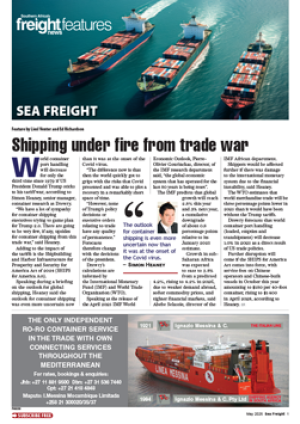Global pressure will be brought to bear on local industry
THIS MONTH'S horrific accident in which a truck carrying chemicals including white spirits, sulphur and paraffin wax plunged over a bridge in Buccleuch, Johannesburg highlights the responsibility placed upon owners and transporters of dangerous goods to ensure that they have adequate risk control and insurance measures in place.
Maritime legal specialist at Alexander Forbes TRMS, Francine Hattingh, points to several direct consequences of the accident for which insurance provision could have been made.
An innocent bystander was killed after being hit by the truck, the driver of the vehicle was injured, containers were damaged, there was concern that the bridge had suffered structural damage, and hazardous chemicals spilled over the road's surface, posing a threat to the environment and in particular the nearby Jukskei River. It is easy to imagine the magnitude of marine and third party liability claims for death, injury and damage to property and the environment which can arise out of any such accident, she said.
In the past, legislation relating to the transportation of dangerous goods contained many grey areas behind which an operator could hide. However replacing the old Hazchem Regulations, Chapter VIII of the Road Traffic Regulations defines the responsibility of the various parties in relation to this sensitive topic and particularly pinpoints liability in the event of an accident.
The regulations are expected to take effect on August 1, 2001, and when this happens the transport operator, warehouseman, consignor and consignee will all be required to be signatories to an agreement relating to any intended transportation of dangerous goods.
The operational requirements are based on the SABS code 0231, which is in turn based on the UN Recommendations for the Transportation of Dangerous Goods. This development is interesting, says Hattingh, because it correlates with the increasing global pressure that we as brokers see being placed on the local transportation industry by the international shipping lines to fall in line with common standards of liability. South Africa for instance has not ratified the European CMR Convention and this allows transporters to escape minimum standards of liability. At least in relation to dangerous goods, this will no longer be possible.
While some transport operators are relatively well acquainted with the regulations, in the past cargo owners have not been required to have any in depth knowledge of the law relating to the transportation of dangerous goods. The new regulations increase the responsibility placed upon them and accordingly we believe that we have an important role to play as a risk solution provider to these clients, in order to ensure that they are adequately covered in respect of any non-compliance with the regulations.
Apart from compliance with the regulations in respect of route, protection and accident plans, the regulations require that adequate insurance should be in place. This is a very wide term and it is imperative that operators (of which the definition includes the owner of the cargo) are fully covered in the event of a failure of these systems to prevent an accident. This would include insurance to cover loss of product, recovery, rehabilitation and third party liabilities. But we would strongly urge all operators to request their broker to conduct a comprehensive risk analysis of the entire transport chain in order to identify any weak areas.
Copyright Now Media (Pty) Ltd
No article may be reproduced without the written permission of the editor
To respond to this article send your email to joyo@nowmedia.co.za
